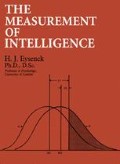Abstract
Psychologists dealing with the application of intelligence tests seem to pass through alternating phases of uncritical overconfidence and cynical despair with regard to the validity of their measurements. To judge by recent utterances the fashionable phase at the moment is disillusionment; the tests do not measure any constant characteristic of the individual, and no two tests measure the same thing.1
Access this chapter
Tax calculation will be finalised at checkout
Purchases are for personal use only
Preview
Unable to display preview. Download preview PDF.
References
Lorimer, F. and Osborn, F.: Dynamics of Population. 1934.
Cattell, Raymond B.: “Some Changes in Social life in a Community with a Falling Intelligence Quotient.” The British Journal of Psychology, Vol. XXVIII, 1938, pp. 430–450.
Neff, W. S.: “Socio-economic Status and Intelligence: a Critical Survey.” Penological Bulletin, Vol. XXXV, No. 10, 1938.
Neff, W. S.: “Socio-economic Status and Intelligence: a Critical Survey.” Penological Bulletin, Vol. XXXV, No. 10, 1938.
Klineberg, O.: Race Differences.
Cattell, Raymond B.: “ Measurement Versus Intuition in Applied Psychology.” Character and Personality, Vol. vl, 1937.
Cattell, Raymond B.: A Guide to Mental Testing] 1936.
Alexander, W. P.: “Intelligence, Concrete and Abstract.” Brit. Journ. Psych. Monograph Supplement, No. 19, 1936.
El Koussy, A. A. H.: “The Visual Perception of Space.” Brit. Journ. Psych. Monograph Supplement, No. 20, 1937.
Reports 1–9 of the Spearman-Holzinger Unitary Trait Study. Psychology Department, University of Chicago, 1935.
Cattell, R. B.: “Temperament Tests. II Tests.” Brit. Journ. Psych., Vol. XIV, 1933.
Cattell, R. B.: A Guide to Mental Testing, 1936.
Burt, C.: “The Latent Revision of the Binet Intelligence Test.” Eugenics Renew, Vol. XXX, No. 4, 1939.
With the same frankness as to the untenability of his position, Burt admits that no two editors of the Binet agree about the order of mental age items. He continues, “The second ‘Paper Cutting Test,’ which Terman assigns to the third or highest level of ‘Superior Adults’ we find can be done at age fourteen” whilst “Giving similarities between three things” is at the eleventh and fourteenth-year-old levels in America and Britain respectively.
Cattell, R. B. and Bristol, H.: “Intelligence Tests for Mental Ages of Four to Eight Years.” Brit. Journ. Ed. Psych., Vol. in, No. II, 1933.
Spearman, C.: “The New Stanford Revision of the Binet.” The Human Factor, Vol. XI, 1937.
Freeman, F. N., Holzinger, E. J., and Newman, H. H.: Twins: A Study of Heredity and Environment, 1937.
Furfey, P. H., and Muhlenbeim, J.: “The Validity of Infant Intelligence Tests.” Journ. Genetic Psych., Vol. XL, 1932, pp. 219–223.
Yet this test happens to be the basis for a widely repeated conclusion that the “intelligence” of nursery-school children has no relation to the intelligence or social status of the parents.
Cox, J. W.: Manual Dexterity, 1935.
Porteufl, S. D.: The Psychology of a Primitive People, 1930.
Porteufl, S. D.: Primitive Intelligence and Environment, 1937.
Davey, C. M.: “A Comparison of Group Verbal and Pictorial Tests of Intelligence.” Brit. Journ. Psych., Vol. XVII, 1926.
Line, W.: “The Growth of Visual Perception in Children.” Brit. Journ. Psych. Monograph Supplement, No. 15, 1931.
Fortes, M.: A New Application of the Theory of Noegenesis to the Problem of Mental Testing. Ph. D. Thesis, Univ. of London library.
Stephenson, W.: “Tetrad Differences for Non-verbal Subtests.” Journ. Educ. Psych., Vol. xxn, 1931.
Stephenson, W.: “Tetrad Differences for Non-verbal and Verbal Tests.” Journ. Educ. Psych., Vol. xxn, 1931.
Spearman, C.: The Spearman Visual Perception Test, 1933.
Arsenian, Seth: “The Spearman Visual Perception Test (Part I). With Pantomime Direction.” Brit. Journ. Educ Psych., Vol. VII, 1937, pp. 287–301.
Dorge, I., and Arsenian, S.: “A Comparison of the Scores of the Spearman Visual Perception Test, Part I, Administered by Verbal and Pantomime Directions.” Journ. Educ Psych., 1938, pp. 520–522.
Reports 1–9 of the Spearman-Holsinger Unitary Trait Study. Psych. Dept., University of Chicago, 1935.
Spearman, C.: Abilities of Man, 1927.
Penrose, L. F., and Raven, J. C.: “A New Series of Perceptual Tests: Preliminary Communication.” Brit. Journ. Medical Psyck., Vol. XVI, 1938.
Portais, S. D.: Primitive Intelligence and Environment, 1937, p. 237; “it is also susceptible to practice improvement.”
Vernon, P. E.: “Intelligence Test Sophistication.” Brit. Journ. Educ. Psych., Vol. VIII, 1938.
Spearman, C.: Abilities of Man, 1927, Chap. XIV.
Thorndike, E. L.: “Tests of Intelligence, Reliability, Significance, Susceptibility to Special Training, and Adaption to the General Nature of the Task,” School and Society, Vol. IX, 1919.
Porteus, S. D.: Primitive Intelligence and Environment, 1937.
Line, W.: “The Growth of Visual Perception in Children.” Brit. Jours. Psych. Monograph Supplement, No. 15, 1931.
Spearman, C.: The Spearman Visual Perception Test, 1933.
Penrose, L. F., and Raven, J. G.: “A New Series of Perceptual Tests: Preliminary Communication.” Brit. Journ. Medical Psych., Vol. XVI, 1936.
Spearman, C.: Abilities of Man, 1927.
Spearman, C.: “Intelligence Tests.” Eugenies Review, Vol. XXX, 1939.
El Koussy, A. H.: “A Note on the Greys Analogy Test.” Brit. Journ. Educ. Psych., Vol. IV, 1938, p. 294.
Porteus, S. D.: The Psychology of a Primitive People, 1931.
Klineberg, O.: “Racial Differences in Speed and Accuracy.” Journal of Abnormal and Social Psychology, Vol. XXII, pp. 273–277.
In the research quoted (Cattell and Bristol, “Intelligence Tests for Mental Ages of Four to Eight Years”) the writers experimented with food (candy) in puzzle boxes for children of four to eight years. The correlations were no better than for tests done under “please the experimenter” motivation.
Wild, E. H.: “Influence of Conation upon Cognition; Part II.” Brit. Journ. Psych., Vol. XVIII, 1927.
Author information
Authors and Affiliations
Rights and permissions
Copyright information
© 1973 H. J. Eysenck
About this chapter
Cite this chapter
Cattell, R.B. (1973). A Culture-Free Intelligence Test I. In: The Measurement of Intelligence. Springer, Dordrecht. https://doi.org/10.1007/978-94-011-6129-9_10
Download citation
DOI: https://doi.org/10.1007/978-94-011-6129-9_10
Publisher Name: Springer, Dordrecht
Print ISBN: 978-94-011-6131-2
Online ISBN: 978-94-011-6129-9
eBook Packages: Springer Book Archive

